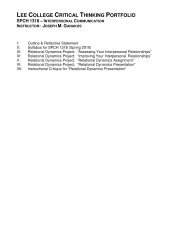Judy Lehmberg (FLC I) - Lee College
Judy Lehmberg (FLC I) - Lee College
Judy Lehmberg (FLC I) - Lee College
Create successful ePaper yourself
Turn your PDF publications into a flip-book with our unique Google optimized e-Paper software.
degrees C. Beaker C had 10 ml of water boiled away. And during that same time, the 100 ml of water in<br />
Beaker A increased by _______________ degrees C.<br />
4. How many calories of heat were required to evaporate the 10 ml of water in Beaker C? (Remember: You<br />
must consider both how much water is in Beaker A and how much its temperature increased while Beaker C<br />
boiled away.)<br />
_____________ calories.<br />
5. So, how many calories would be required to evaporate only 1 ml of water?<br />
_____________ calories.<br />
6.What does this exercise tell you about calories, exercise, and sweating?<br />
As you exercise your body temperature increases. Some of that heat can be released as water molecules leave<br />
your body.<br />
Practice 6 - What the Heck is pH?<br />
HYDROGEN IONS An ion is an atom that has lost or gained electrons, and thereby has become electrically<br />
charged (either + or -). They act differently than uncharged atoms. (It's like comparing magnets with nonmagnets.)<br />
These ions are very important in out life processes, and we would die without them. Table salt is an example of<br />
two essential ions -- sodium and chloride.<br />
Of all the ions in your body, none is more important than the hydrogen ion, H+. The term "pH" refers to the<br />
concentration of H+ ions in water. Biologists are interested in H+ concentration because it affects chemical<br />
reactions so greatly.<br />
A small change in this ion can dramatically affect life. Acid rain and stomach acid are two expressions of the<br />
concentration of H+ ions. Also, the blood of a human is so sensitive to H+ concentration that a small pH<br />
change from your normal of 7.4 can result in your death.<br />
We monitor the pH of our fish aquariums and our swimming pools in order to avoid potential problems. In the<br />
case of the aquarium, we are trying to maintain a good environment for micro-organisms, whereas, in the<br />
swimming pool, we are trying to prevent micro-organisms from growing.<br />
QUESTIONS:<br />
1. Knowing how important pH can be to living organisms, what would be the effect of acid rain on the<br />
ecosystem?<br />
It can have devastating effects on organisms, especially aquatic organisms. There are many bodies of water<br />
that are now biologically dead due to low pH as a result of acid rain.<br />
2. What does the "p" stand for in pH?<br />
Potential, it is the potential of hydrogen.<br />
The pH scale ranges from 1 to 14. Each step up the pH scale means that there is 10x more OH- (base) and less<br />
H+ (acid) than the step below.<br />
34
















